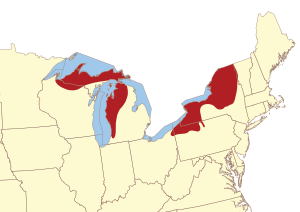Fruit Belt facts for kids

A Fruit Belt is a special area in the United States. In these places, the weather and land are just right for growing lots of fruit. It's like nature's perfect garden spot!
What is a Fruit Belt?
A Fruit Belt is a region where a unique type of weather, called a microclimate, helps fruit trees and plants grow very well. A microclimate is like a small weather system that is different from the general weather around it. For example, it might be a bit warmer or have more moisture. This special local weather makes it easy for farmers to grow fruits like apples, cherries, and peaches.
Where are Fruit Belts Found?
Many Fruit Belts are found around the Great Lakes in North America. These include areas in West Michigan and western Northern Michigan. The southern shore of Lake Erie is also a big Fruit Belt. Another important Fruit Belt is in Central Washington State. You can also find places on the West Coast where berries grow very well.
Why are These Areas Special?
The same weather conditions that create "lake-effect snow" also create Fruit Belts. Lake-effect snow happens when cold air moves over warmer lake waters. This picks up moisture and drops it as snow on the land nearby.
This process helps fruit growing in a few ways. The lakes can make the air warmer in winter, protecting fruit trees from extreme cold. They can also keep the air cooler in spring, stopping fruit trees from blooming too early. This protects the flowers from late frosts. So, places that get a lot of lake-effect snow often have great conditions for fruit farms. The map on the right shows areas that get lake-effect snow. These areas often overlap with Fruit Belts.

